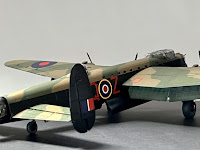While not the classic Lancaster we’re used to seeing, I just had to build this rare incarnation of probably the most iconic bomber of the War. It is indeed a rarity, in that it made up just 4% of the total number of Lancasters produced, it remained in frontline service for no more than a year and none survived beyond 1950.
The uniqueness of this aircraft is that rather than having the standard Rolls-Royce Merlin engines, the Lancaster Mk II. due to concerns over the supply of the Merlins, were fitted with Bristol Hercules radial engines. As it happened, by the time the Mk II entered service in October 1942, the threat to the Merlin supply was already receding and as such only 300 Mk IIs were produced.
The Hercules engine’s performance was found to be not as good as the Merlin. The maximum operational altitude the Mk II could achieve was between 14,000 - 18,000 feet as opposed to the greater and considerably safer altitude of 22,000 feet of the Mk I. Fortuitously, in not requiring the merlin’s liquid cooling systems, the Mk II could take a little more punishment.
The Mk II also received an additional protection in the installation of a FN64 ventral turret situated behind the bomb bay; though many crews removed these to save weight. A second problem with the Mk II was that it could only carry 14,000 lbs of bombs, compared to the 18,000 of the Mk I. Thus, by the end of 1943, it was no surprise to find the Lancaster Mk II being phased out.
A couple of additions I made to the completed build were the set of bombs sourced from the RAF Resupply Set as Airfix no longer provide these with the kit, and I drilled out and filled with liquid glazing the windows in the escape hatches. It seems odd to me that in their 1960s kit these were included while in the 2020s moulding, the many side windows are added, but the escape hatch windows are omitted!
In it being Halloween, it seemed only right to finish my Airfix Mk II in the markings of “Z-Zombie”, LL725, of No. 408 (Goose) Squadron, 6 Group, Royal Canadian Air Force, based at RAF Linton-on-Ouse, Yorkshire, in July 1944.
And in researching the back story as to why this aircraft carries the Zombie Nose Art, I dredged up the following account by the aircraft’s rear-gunner and nose artist, George Oliver:
… for some reason the call sign at Linton-on-Ouse, Yorkshire, was changed from Z-Zebra, to Z-Zombie. On their 8th operation to Essen, Germany on 24 March 1944, they lost an engine and had the option to dump their bomb load and return to base or to carry on. The crew agreed to press on but arrived over the target late and all alone. After the release of their bomb load they were met with intense ack-ack and were lucky to escape. On return to base they discovered that they had been posted as lost in action. It was following this experience they all agreed “Zombie” [return of the living dead] should become the nose art, and so it was.














